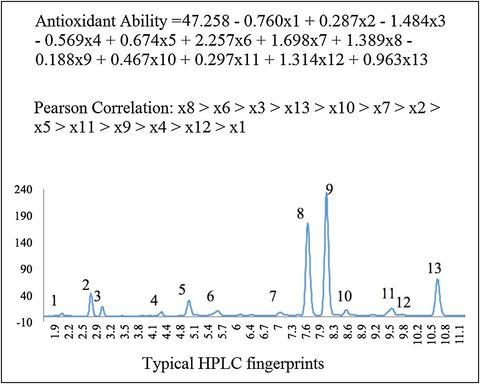当前位置:
X-MOL 学术
›
J. Food Biochem.
›
论文详情
Our official English website, www.x-mol.net, welcomes your
feedback! (Note: you will need to create a separate account there.)
The contribution ratio of various characteristic tea compounds in antioxidant capacity by DPPH assay.
Journal of Food Biochemistry ( IF 3.5 ) Pub Date : 2020-05-11 , DOI: 10.1111/jfbc.13270 Yansu He 1, 2 , Yong Lin 3 , Qingsheng Li 4 , Yuxuan Gu 2
Journal of Food Biochemistry ( IF 3.5 ) Pub Date : 2020-05-11 , DOI: 10.1111/jfbc.13270 Yansu He 1, 2 , Yong Lin 3 , Qingsheng Li 4 , Yuxuan Gu 2
Affiliation

|
Tea is a worldwide health beneficial beverage for its antioxidant ability. 1,1‐diphenyl‐2‐picryl‐hydrazyl (DPPH) assay is a common method to measure the antioxidant capacity of tea compounds, yet the contribution ratio of various characteristic tea compounds is still unclear. high‐performance liquid chromatography (HPLC) was used to examine the content of polyphenol compounds in 24 tea samples from four tea categories (green tea, white tea, oolong tea, and black tea). Based on the results of DPPH and HPLC, contribution ratio of each tea compound was analyzed by the Pearson correlation analysis and the partial least squares regression (PLSR). The Pearson correlation analysis showed that the order of correlation between the area of 13 peaks and the antioxidant ability of tea samples was x8 > x6 > x3 > x13 > x10 > x7 > x2 > x5 > x11 > x9 > x4 > x12 > x1; the regression equation fit by PLSR was Y = 47.258 − 0.760x1 + 0.287x2 − 1.484x3 − 0.569x4 + 0.674x5 + 2.257x6 + 1.698x7 + 1.389x8 − 0.188x9 + 0.467x10 + 0.297x11 + 1.314x12 + 0.963x13. We identified nine common peaks by reference standard substances: the x3 was gallic acid (GA), x4 was theobromine, x5 was catechuic acid (CA), x6 was epigallocatechin (EGC), x8 was epigallocatechin gallate (EGCG), x9 was caffeine, x10 was epicatechin (EC), x12 was epicatechin gallate (ECG), and x13 was gallocatechin gallate (GCG). Based on the study of spectrum‐effect correlation, we obtain a better understanding of the antioxidant activity of complex tea polyphenols component.
中文翻译:

通过DPPH测定,各种特色茶化合物对抗氧化能力的贡献率。
茶因其抗氧化能力而成为一种对全球健康有益的饮料。1,1-二苯基-2-吡啶基-肼基(DPPH)测定法是测量茶化合物抗氧化能力的常用方法,但各种特征茶化合物的贡献率仍不清楚。高效液相色谱(HPLC)用于检查来自四个茶类(绿茶,白茶,乌龙茶和红茶)的24种茶样品中多酚化合物的含量。根据DPPH和HPLC的结果,通过Pearson相关分析和偏最小二乘回归(PLSR)分析每种茶化合物的贡献率。皮尔逊相关分析表明,13个峰的面积与茶叶样品的抗氧化能力之间的相关顺序为x8> x6> x3> x13> x10> x7> x2> x5> x11> x9> x4> x12> x1; PLSR拟合的回归方程为Y = 47.258 − 0.760x1 + 0.287x2 − 1.484x3 − 0.569x4 + 0.674x5 + 2.257x6 + 1.698x7 + 1.389x8 − 0.188x9 + 0.467x10 + 0.297x11 + 1.314x12 + 0.963x13 我们通过参考标准物质确定了9个常见峰:x3是没食子酸(GA),x4是可可碱,x5是儿茶酸(CA),x6是表没食子儿茶素(EGC),x8是没食子儿茶素没食子酸酯(EGCG),x9是咖啡因, x10是表儿茶素(EC),x12是表儿茶素没食子酸酯(ECG),x13是没食子儿茶素没食子酸酯(GCG)。通过对光谱效应相关性的研究,我们可以更好地了解复杂茶多酚成分的抗氧化活性。257x6 + 1.698x7 + 1.389x8-0.188x9 + 0.467x10 + 0.297x11 + 1.314x12 + 0.963x13。我们通过参考标准物质确定了9个常见峰:x3是没食子酸(GA),x4是可可碱,x5是儿茶酸(CA),x6是表没食子儿茶素(EGC),x8是没食子儿茶素没食子酸酯(EGCG),x9是咖啡因, x10是表儿茶素(EC),x12是表儿茶素没食子酸酯(ECG),x13是没食子儿茶素没食子酸酯(GCG)。通过对光谱效应相关性的研究,我们可以更好地了解复杂茶多酚成分的抗氧化活性。257x6 + 1.698x7 + 1.389x8-0.188x9 + 0.467x10 + 0.297x11 + 1.314x12 + 0.963x13。我们通过参考标准物质确定了9个常见峰:x3是没食子酸(GA),x4是可可碱,x5是儿茶酸(CA),x6是表没食子儿茶素(EGC),x8是没食子儿茶素没食子酸酯(EGCG),x9是咖啡因, x10是表儿茶素(EC),x12是表儿茶素没食子酸酯(ECG),x13是没食子儿茶素没食子酸酯(GCG)。通过对光谱效应相关性的研究,我们可以更好地了解复杂茶多酚成分的抗氧化活性。x9是咖啡因,x10是表儿茶素(EC),x12是表儿茶素没食子酸酯(ECG),x13是没食子儿茶素没食子酸酯(GCG)。通过对光谱效应相关性的研究,我们对复杂茶多酚成分的抗氧化活性有了更好的了解。x9是咖啡因,x10是表儿茶素(EC),x12是表儿茶素没食子酸酯(ECG),x13是没食子儿茶素没食子酸酯(GCG)。通过对光谱效应相关性的研究,我们可以更好地了解复杂茶多酚成分的抗氧化活性。
更新日期:2020-05-11
中文翻译:

通过DPPH测定,各种特色茶化合物对抗氧化能力的贡献率。
茶因其抗氧化能力而成为一种对全球健康有益的饮料。1,1-二苯基-2-吡啶基-肼基(DPPH)测定法是测量茶化合物抗氧化能力的常用方法,但各种特征茶化合物的贡献率仍不清楚。高效液相色谱(HPLC)用于检查来自四个茶类(绿茶,白茶,乌龙茶和红茶)的24种茶样品中多酚化合物的含量。根据DPPH和HPLC的结果,通过Pearson相关分析和偏最小二乘回归(PLSR)分析每种茶化合物的贡献率。皮尔逊相关分析表明,13个峰的面积与茶叶样品的抗氧化能力之间的相关顺序为x8> x6> x3> x13> x10> x7> x2> x5> x11> x9> x4> x12> x1; PLSR拟合的回归方程为Y = 47.258 − 0.760x1 + 0.287x2 − 1.484x3 − 0.569x4 + 0.674x5 + 2.257x6 + 1.698x7 + 1.389x8 − 0.188x9 + 0.467x10 + 0.297x11 + 1.314x12 + 0.963x13 我们通过参考标准物质确定了9个常见峰:x3是没食子酸(GA),x4是可可碱,x5是儿茶酸(CA),x6是表没食子儿茶素(EGC),x8是没食子儿茶素没食子酸酯(EGCG),x9是咖啡因, x10是表儿茶素(EC),x12是表儿茶素没食子酸酯(ECG),x13是没食子儿茶素没食子酸酯(GCG)。通过对光谱效应相关性的研究,我们可以更好地了解复杂茶多酚成分的抗氧化活性。257x6 + 1.698x7 + 1.389x8-0.188x9 + 0.467x10 + 0.297x11 + 1.314x12 + 0.963x13。我们通过参考标准物质确定了9个常见峰:x3是没食子酸(GA),x4是可可碱,x5是儿茶酸(CA),x6是表没食子儿茶素(EGC),x8是没食子儿茶素没食子酸酯(EGCG),x9是咖啡因, x10是表儿茶素(EC),x12是表儿茶素没食子酸酯(ECG),x13是没食子儿茶素没食子酸酯(GCG)。通过对光谱效应相关性的研究,我们可以更好地了解复杂茶多酚成分的抗氧化活性。257x6 + 1.698x7 + 1.389x8-0.188x9 + 0.467x10 + 0.297x11 + 1.314x12 + 0.963x13。我们通过参考标准物质确定了9个常见峰:x3是没食子酸(GA),x4是可可碱,x5是儿茶酸(CA),x6是表没食子儿茶素(EGC),x8是没食子儿茶素没食子酸酯(EGCG),x9是咖啡因, x10是表儿茶素(EC),x12是表儿茶素没食子酸酯(ECG),x13是没食子儿茶素没食子酸酯(GCG)。通过对光谱效应相关性的研究,我们可以更好地了解复杂茶多酚成分的抗氧化活性。x9是咖啡因,x10是表儿茶素(EC),x12是表儿茶素没食子酸酯(ECG),x13是没食子儿茶素没食子酸酯(GCG)。通过对光谱效应相关性的研究,我们对复杂茶多酚成分的抗氧化活性有了更好的了解。x9是咖啡因,x10是表儿茶素(EC),x12是表儿茶素没食子酸酯(ECG),x13是没食子儿茶素没食子酸酯(GCG)。通过对光谱效应相关性的研究,我们可以更好地了解复杂茶多酚成分的抗氧化活性。











































 京公网安备 11010802027423号
京公网安备 11010802027423号